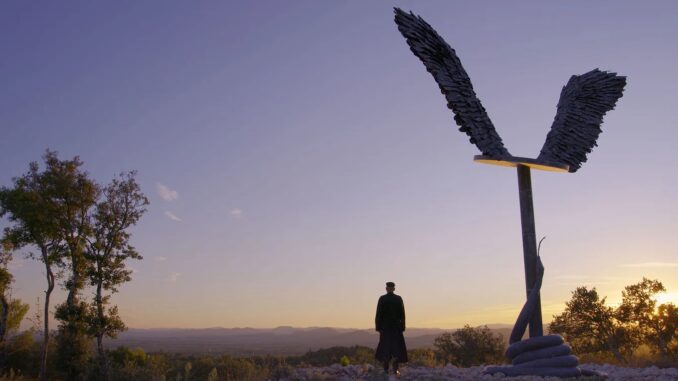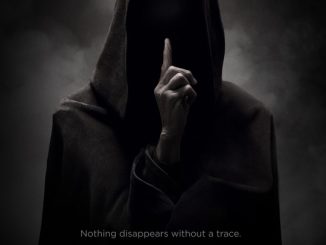
From the opening shot of the film neither the 3D camera’s eye nor its subject artist, Anselm Kiefer, ever stops moving. The camera floats through his works and the landscapes he creates, following the 78 year old artist as he bicycles or paddles through his cavernous art factory to landscapes of his past as a youth. Looking like a possessed construction worker he slides giant canvases into position for well placed pours of molten lava like material and then travels to torch other surfaces.
Kiefer’s art is not static he constantly changes and redefines it’s look by various means including fire and exposure to the elements. His unfinished works, always open to inspiration, is a source of joy for the creator but a bit of a nightmare for gallery owners. It literally does speak to us through the whispered poetry and haunting soundtrack.
Kiefer, grew up in the emotional, physical and philosophical rubble of post war Germany and this is what gives the movie its weight and in many ways the artist his purpose. In a sense it started at birth, where his mother and fathers life was spared as their house was reduced to rubble by bombs targeting a nearby military garrison while he was delivered in an underground bunker. As a child he said this rubble was his toys and the structures he built from them were his first works. The young prodigy Kiefer, is depicted by Wim Wenders’ grand nephew Anton and the emerging artist of the 60’s by Kiefer’s son Daniel, who are a major presence in the film as is Kiefer’s past. A scene with Daniel giving the Nazi salute references one of his most controversial works, the photo book Occupations (1969), where Kiefer gave Nazi salute in culturally significant locations. Displaying a past that many in Germany wanted to forget, it caused a wave of criticism.
Add to that huge paintings of the crumbling monuments commissioned by Hitler often scarred or burnt, ; illustrating the impermanence of the foundation upon which the Nazi mythos was built. Anselm attributes the direction in this work and others we see to poet and Holocaust survivor Paul Celan whose poetry is “like a buoy that I swim to from one direction to another.” In fact he points out, “That there is practically no landscape in Europe that is not injured.” That at some point in history was not the scene of some battle or where blood was shed. Far from being depressing the upbeat and energized Keifer may be saying to the worst mankind creates, “This too shall pass.” “The Bible constantly says everything will be destroyed — and grass will grow over your cities. I think that’s fantastic. And grass will grow here too. It already is, everywhere.” Kiefer says.
Wenders, who was also born in 1945, defended Anselm against his critics, who misunderstood it’s purpose or the Nazi images, arguing that the salute like much of Kiefer’s art was a battle against those who would forget the past. The danger is not remembering Wenders said, which can be seen in the rise of unbridled nationalism in the world today. Wenders was not alone in praising Kiefer, who was awarded The Peace Prize by The German Book Trade (2008) and more recently Grand Federal Cross of Merit with Star in Paris.
Besides accenting the multidimensionality of Kiefer’s work and surroundings Wenders chose 3D camera because he said viewing Kiefer’s work, like the windowless towers looming like skeletons of bombed out buildings or wings planted on a hill, activates centers in your brain so you are affected more deeply by his creations. And the 3D here is devoid of the “in your face 3D gimmicks” of the more recent use of the medium. A lead 3D cameraman once said to me the purpose of 3D should be to deliver reality not distort it. And in sharp focus the unbridled creativity and energy we see and feel from the 78 year olds, Kiefer the artist and director Wenders, is a testament of what we can create at any age. Much the same as what he did in Buena Vista Social Club he has given center stage to great artists and let their art speak for itself. Leaving the commentary to writers to catalog the thrills. See Anselm in 3D in theaters December 15th. And if you happen to be visiting Southern France you can book a tour to Anselm Kiefer’s 200 acre studio in Southern France which opens for tours in 2024.




Great article ! I can’t wait to see it – his work made me cry in Venice last year !
The name of the artist is KIEFER !